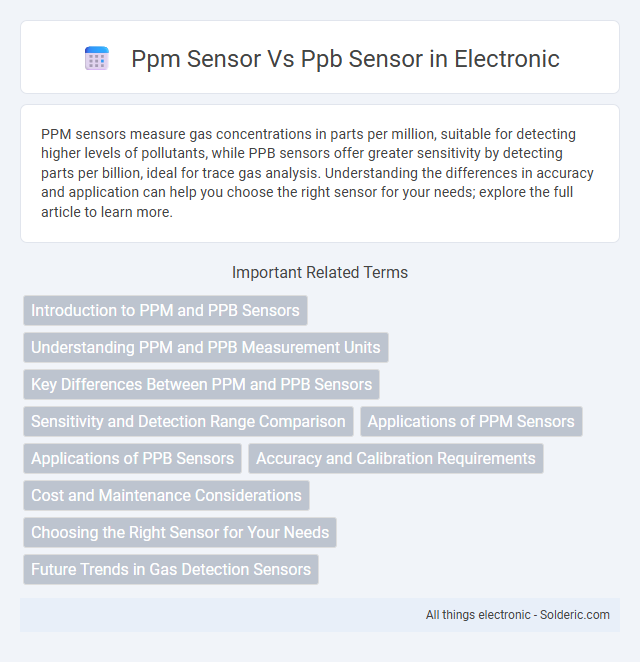PPM sensors measure gas concentrations in parts per million, suitable for detecting higher levels of pollutants, while PPB sensors offer greater sensitivity by detecting parts per billion, ideal for trace gas analysis. Understanding the differences in accuracy and application can help you choose the right sensor for your needs; explore the full article to learn more.
Comparison Table
| Feature | PPM Sensor | PPB Sensor |
|---|---|---|
| Detection Range | Parts Per Million (1 ppm to 1000+ ppm) | Parts Per Billion (1 ppb to 1000+ ppb) |
| Sensitivity | Lower sensitivity | Higher sensitivity |
| Applications | Industrial gas monitoring, air quality control | Environmental monitoring, toxic gas detection |
| Cost | Generally lower cost | Typically higher cost due to advanced detection |
| Response Time | Faster for higher concentration detection | Slower, optimized for trace gas detection |
| Accuracy | Good for moderate concentrations | High accuracy for trace levels |
Introduction to PPM and PPB Sensors
PPM sensors measure gas concentrations in parts per million, suitable for detecting higher levels of pollutants or industrial gases, while PPB sensors detect substances at parts per billion, offering greater sensitivity for trace gas analysis. These sensors are critical in environmental monitoring, industrial safety, and air quality control, enabling precise detection based on the required sensitivity. Your choice between PPM and PPB sensors depends on the specific application and the concentration range of gases you need to monitor.
Understanding PPM and PPB Measurement Units
PPM (parts per million) and PPB (parts per billion) both quantify the concentration of substances within air, water, or other mediums, where 1 PPM equals 1,000 PPB. PPM sensors detect higher concentration levels, ideal for monitoring pollutants or gases in industrial environments, while PPB sensors measure trace amounts with greater sensitivity critical for detecting toxic pollutants in environmental and health applications. Your choice of sensor depends on the precision needed to measure specific contaminants accurately.
Key Differences Between PPM and PPB Sensors
PPM sensors measure concentrations in parts per million, suitable for detecting higher levels of gases, while PPB sensors detect much lower concentrations in parts per billion, ideal for trace gas analysis. PPB sensors offer greater sensitivity and precision, making them essential for applications requiring ultra-low detection limits, such as air quality monitoring or hazardous gas detection. Your choice depends on the required detection range and sensitivity for accurate environmental or industrial gas assessments.
Sensitivity and Detection Range Comparison
PPM sensors detect gas concentrations in parts per million, offering lower sensitivity and a broader detection range ideal for general air quality monitoring. PPB sensors measure concentrations in parts per billion, providing significantly higher sensitivity for detecting trace levels of gases in applications like industrial safety and environmental research. The detection range of PPB sensors is narrower but more precise, making them essential for early warning systems and compliance with stringent regulatory standards.
Applications of PPM Sensors
PPM sensors are widely used in industrial gas detection, indoor air quality monitoring, and environmental pollution control due to their ability to measure gas concentrations in parts per million, ideal for detecting higher concentration levels. These sensors are essential for monitoring carbon monoxide, methane, and volatile organic compounds in safety-critical environments such as manufacturing plants and HVAC systems. Their robustness and cost-effectiveness make them suitable for applications requiring real-time gas concentration analysis in moderate contamination scenarios.
Applications of PPB Sensors
PPB sensors are crucial in applications requiring ultra-trace detection of contaminants, such as indoor air quality monitoring, industrial emissions control, and environmental research. These sensors detect pollutant concentrations at parts-per-billion levels, enabling early warning of hazardous gases like volatile organic compounds (VOCs) and toxic substances. Unlike PPM sensors, PPB sensors provide higher sensitivity and precision essential for health safety regulations and scientific analysis.
Accuracy and Calibration Requirements
PPB sensors offer higher accuracy compared to PPM sensors, detecting trace gas concentrations at parts-per-billion levels crucial for sensitive environmental monitoring. These sensors require more frequent and precise calibration to maintain reliability due to their heightened sensitivity and susceptibility to drift. You should consider the specific accuracy needs and calibration complexity when choosing between PPM and PPB sensors for gas detection applications.
Cost and Maintenance Considerations
PPM sensors generally cost less and require simpler maintenance compared to PPB sensors, making them more suitable for basic air quality monitoring where high sensitivity is not critical. PPB sensors demand higher investment due to advanced technology and frequent calibration to maintain accuracy at ultra-low concentration levels. The increased maintenance complexity and operational costs for PPB sensors are justified only in environments where detecting trace gases at parts-per-billion is essential.
Choosing the Right Sensor for Your Needs
Selecting the appropriate sensor depends on the required detection sensitivity; ppm sensors detect parts per million concentrations, ideal for general air quality and industrial applications, while ppb sensors measure parts per billion, essential for trace gas analysis and highly sensitive environmental monitoring. Consider the target gas concentration, measurement accuracy, and application scope when choosing between ppm and ppb sensors. Cost and calibration complexity also influence sensor selection, with ppb sensors generally being more expensive and requiring precise maintenance.
Future Trends in Gas Detection Sensors
Future trends in gas detection sensors emphasize increased sensitivity and accuracy, with PPB sensors enabling detection at parts-per-billion levels for precise monitoring of trace gases in environmental and industrial applications. Advances in nanomaterials and microelectromechanical systems (MEMS) technology are driving the development of compact, low-power PPB sensors with enhanced selectivity and faster response times compared to traditional PPM sensors. Integration of IoT connectivity and AI algorithms facilitates real-time data analysis and predictive maintenance, positioning PPB sensors as critical tools for future smart gas sensing networks.
ppm sensor vs ppb sensor Infographic

 solderic.com
solderic.com